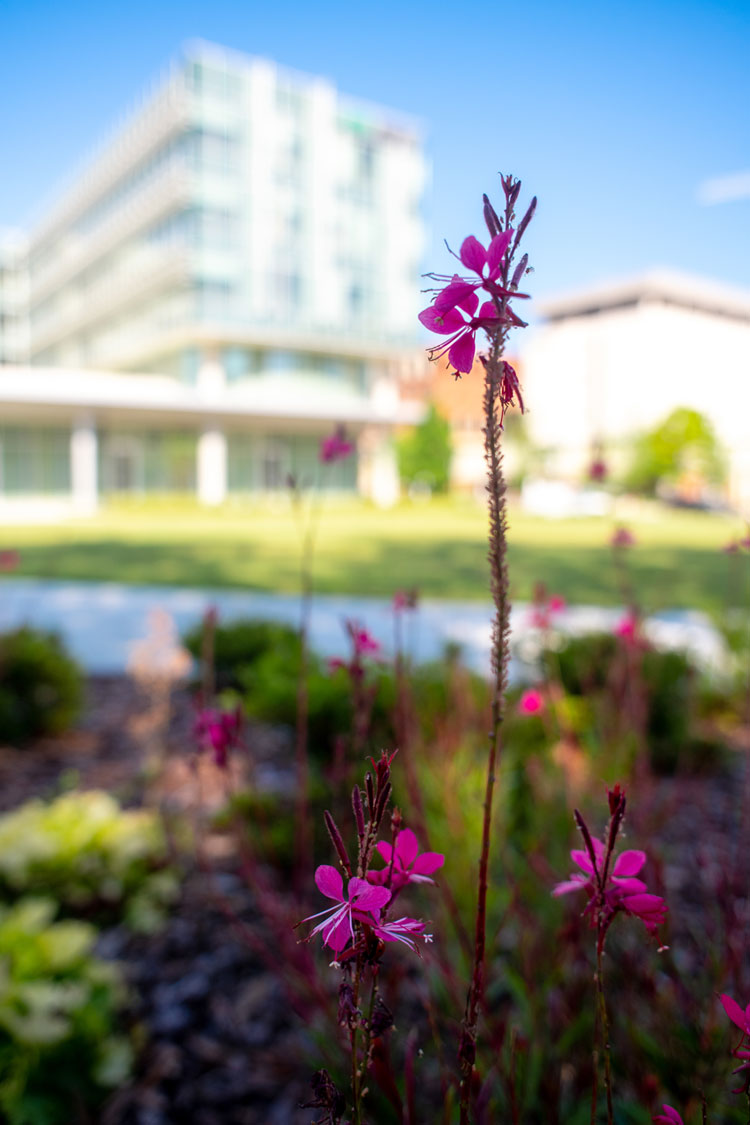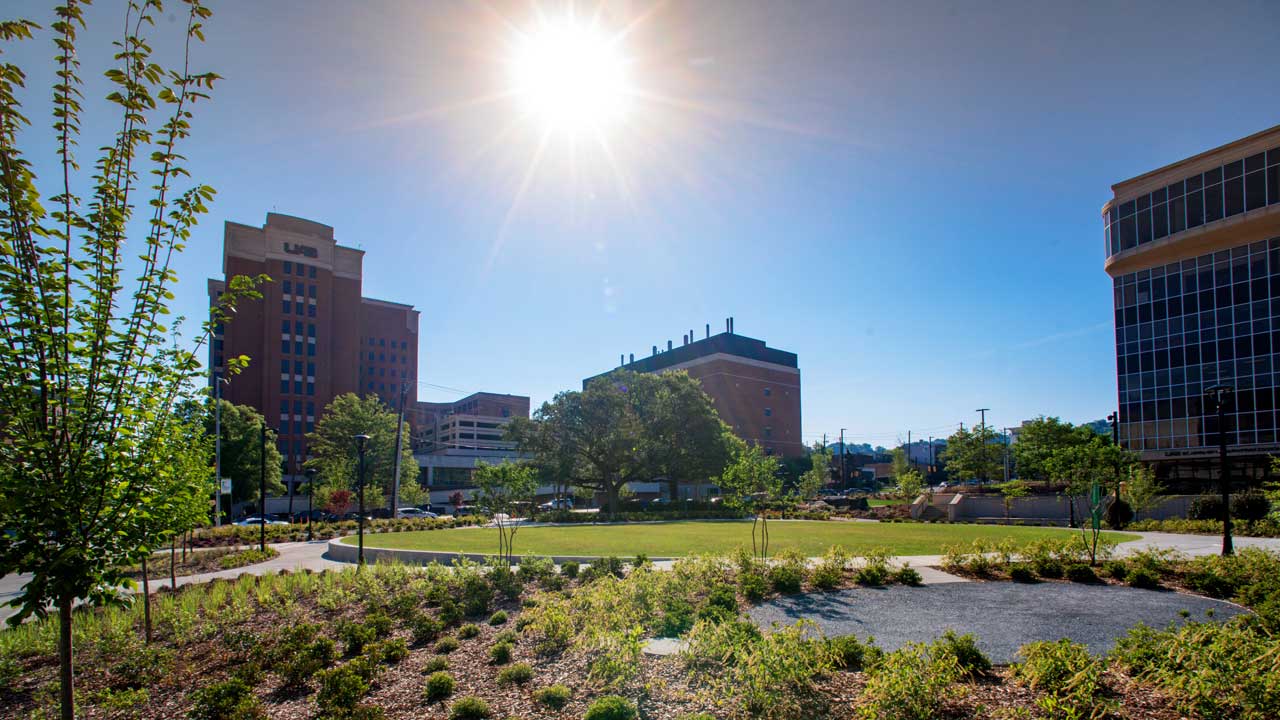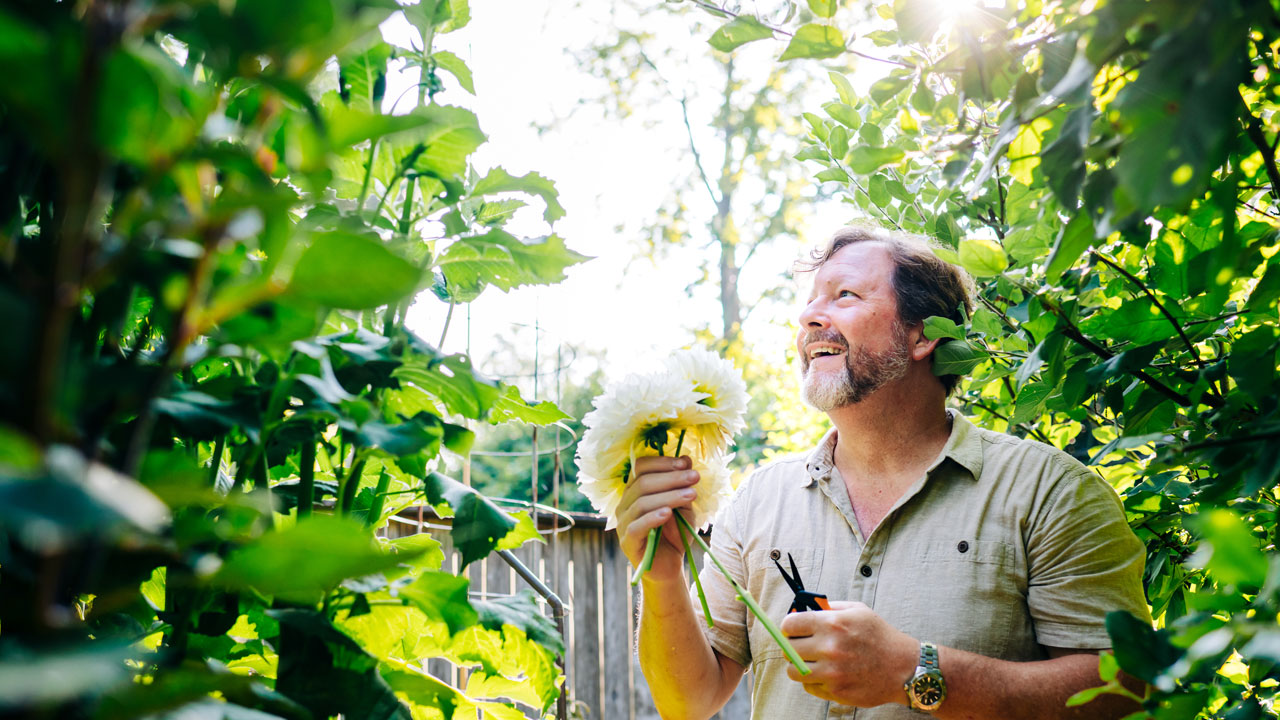When J. Crawford Downs, Ph.D., arrives home after the eight-minute commute from his lab at UAB’s Volker Hall, he heads straight from his car to the garden in the backyard. “My wife has said that I often arrive home still ‘on fire’ from the office,” said the professor of ophthalmology, biomedical engineering, and computer science. “Heading straight to the garden to process and de-stress from my workday is great for me—and for the family.”

After work and on the weekends, he plans and plants the plot with his favorite vegetables, as well as herbs such as thyme and bay. He grows the dahlias and zinnias for his wife, Georgia. “I started growing flowers for her during the pandemic. They bring a splash of color into the house throughout the spring, summer, and early fall.”
He spends a lot of time in the fresh air, where crepe myrtles, Asian pear, plum, and magnolia trees provide strategic shade and birds keep watch among the ripening figs. “If I’m not in a rebuilding year, I spend roughly two full weekends prepping beds and planting in the spring and fall,” he said, noting that the weeding, pruning, and harvesting consume as much as 40 additional hours throughout the season. His dogs often sit just outside the perimeter of the garden, hoping for a stray green bean to be tossed their way.
Anne Markham Bailey, a teaching artist with UAB Arts in Medicine, recently conducted a webinar for the Heersink School of Medicine. She discussed how time spent engaging with nature can reduce stress, improve mood, foster resilience, and enhance overall health. “We know that the world is always working on us,” she said later. “The trees are off-gassing volatile organic compounds that are good for us. The soil contains microbes that contribute to our feelings of being happy. Then there’s our deeper relationship with the sun. All of this contributes to us feeling good, feeling happy, feeling like ourselves, perhaps, when we’re in nature. We don’t have to try. We’re just being alive.”
As an ecotherapy guide, Bailey conducts intentional immersion sessions to benefit both physical and mental wellbeing. Immersion can take the form of time spent in a forest, a garden, a park, or even simply spent in a room full of plants and sunshine. “It’s a process of opening your senses,” she said. “It’s actually mindless, rather than mindful.”
Research by professors in the UAB School of Health Professions supports the correlation between time spent in green spaces and improved health and wellbeing. Gavin R. Jenkins, Ph.D., chair of the Department of Occupational Therapy, and Director of Research Hon K. Yuen, Ph.D., studied visitors at urban parks, who reported positive changes in subjective measures of wellbeing after just 20.5 minutes. Lab results showed changes in cortisol and DHEA in 21.8 minutes.
That’s a significant return on just 21 minutes outside.
“The evidence shows us that even small periods of time immersed in a green space can have a positive impact, and we have such great spaces across campus,” said Jenkins of UAB’s urban landscape that has been designed with trees in mind.
Jenkins hopes to one day transform an unused patch of grass outside the School of Health Professions Building into a small sanctuary garden to benefit students, faculty, and visitors. “The reality is that if we all just connected and went outside during the day, we would experience health benefits. We don’t need to be active—to just sit in a green space is all we need to do.”
For those with severe health issues, studies show that views of nature can make significant differences in intensive care units, Jenkins noted, even when that view is simply a painting or photograph of a natural setting on otherwise blank walls. Patients who could see a picture of nature showed less anxiety, needed fewer pain medications, and suffered less temporary cognitive impairment. “There is even some evidence that among ICUs that do have natural light, mortality rates tend to be lower in those that are sunnier,” he said.
“The evidence shows us that even small periods of time immersed in a green space can have a positive impact, and we have such great spaces across campus.”
—Gavin R. Jenkins, Ph.D.
For Crawford Downs—who’s accustomed to rigorous days in the research lab—the benefits of spending time working outside in his garden are therapeutic, to be sure, but there’s more to it than that. He also likes the challenge of increasing his yield while enjoying the fruits of his labor. “It gives me something tangible and manual to do with my hands. I really appreciate that since I spend a lot of time on intellectual pursuits at work, largely sitting behind my desk on a computer or doing detailed experimental work,” he said. “And there is nothing like a fresh green bean, pepper, or ripe heirloom tomato just off the vine.”
21 minutes outside
Research shows that spending time in an urban park can influence cortisol and DHEA. Here are just a few spots around campus to get a breath of fresh air.
Unity Park
at the corner of University Boulevard and 18th Street South
Mini Park
at the corner of University Boulevard and 13th Street South
Campus Green
University Boulevard between 14th Street South and 16th Street South
The Solar House and Sustainable Community
11th Avenue South and 17th Street
The Park of Hope
Sixth Avenue South and 18th Street




